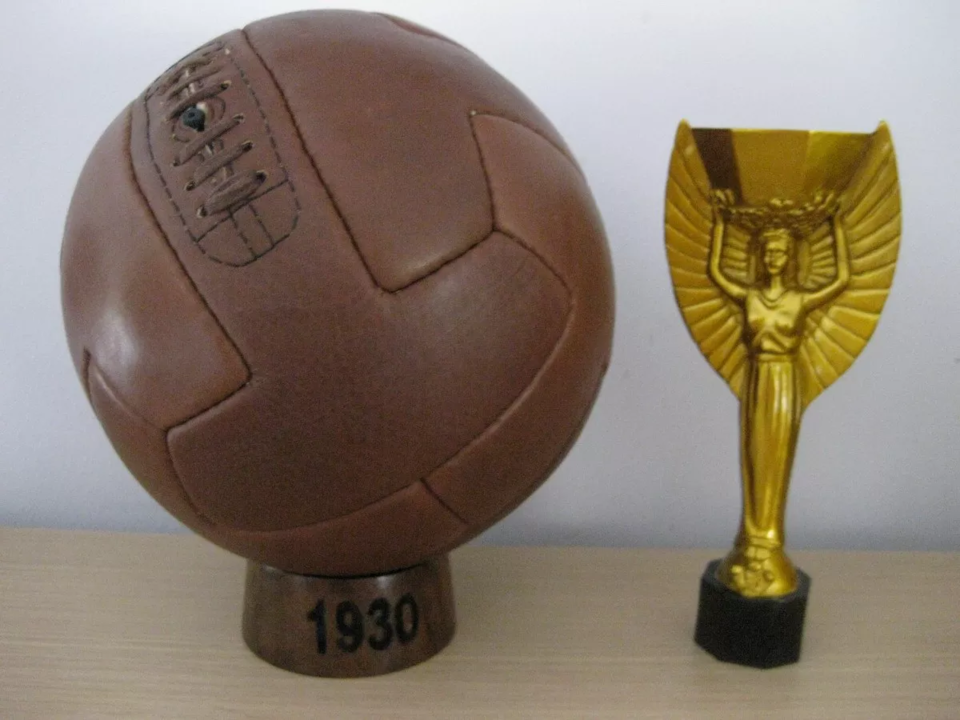Cet article est paru pour la première fois dans la revue dans la Revue Telecom, et est réédité à l'occasion du #Mondial2018.
Le football est le sport le plus populaire sur terre, pratiqué régulièrement par plus de 300 millions de joueurs. Or entre les premiers matches organisés par la Football Association en Angleterre au XIXe siècle, et notre pratique actuelle, qu’est-ce qui a changé ? “Je suis surpris que, à notre époque où l’innovation est omniprésente dans tous les domaines, rien ne soit fait pour le foot.” affirme Jacques-Henri Eyraud, président de l’Olympique de Marseille, club phare du football français. Pas si étonnant quand on sait qu’une autre légende du football français, Michel Platini, s’est publiquement prononcé à de multiples reprises contre la mise en place de certains dispositifs technologiques comme l’arbitrage vidéo ; le football devrait rester un sport populaire, un langage universel, que tout le monde peut pratiquer à partir d’une simple balle. Mais ses pratiquants, dont les habitudes évoluent, que cela leur plaise ou non, au rythme effréné imposé par les avancées technologiques, n’auraient-ils pas envie de voir leur sport favori évoluer avec eux ?
Je vous propose un tour d’horizon de l’évolution du football telle que je la perçois, du haut de mes cinq années à la direction d’une start-up qui met les technologies de pointe au service des joueurs amateurs.
Le mauvais exemple du foot pro
Il est un aspect du sport auquel on pense directement quand on essaie de l’aborder à travers un prisme scientifique, c’est l’analyse statistique des performances. Or on ne parle pas ici de nouveauté puisque dès les années 1950, l’analyste anglais Charles Reep, fait le constat, que nous caricaturerons de la manière suivante : plus le ballon est présent dans la surface adverse, plus vous avez de chances de marquer, il convient donc, dès que vous avez le ballon, de l’envoyer le plus rapidement possible dans la surface adverse. Ainsi naissait la stratégie du kick and rush, qui, bien qu’éternellement discutée, est toujours utilisée par certaines équipes aujourd’hui.
Si les stats sont prises en compte depuis un demi-siècle, c’est uniquement ces dernières années qu’on constate leur explosion, en témoigne l'essor de sociétés comme Opta (rachetée en 2013 par un groupe média pour 60 millions de dollars), dont l’activité consiste à collecter des données sur le jeu pour les revendre en temps réel aux médias notamment. Et comment ces acteurs génèrent-ils la donnée ? Et bien désolé de casser un mythe, mais il y a bel et bien un employé qui regarde chaque match et note les actions une par une. Ou plutôt trois employés, un pour chaque équipe et un qui supervise. Assez pour nourrir l'appétit grandissant en statistiques du grand public, notamment des amateurs de paris sportifs, mais on est loin d’une révolution technologique qui changera la manière dont chacun d’entre nous pratique le football.
Que se passe-t-il quand les matchs ne sont pas filmés ? Les équipes pros mesurent-elles leur données pendant les séances d'entraînement ? On est désormais habitués à voir ces joueurs à l'entraînement revêtir des “brassières GPS” qui nous feraient tendre à croire que c’est le cas. Un joli coup de communication pour ces fabricants de brassières qui s’affichent ainsi au torse des plus grand joueurs en échange, on l’imagine, d’un tarif moindre, mais les données collectées sont-elles réellement exploitées ? La société allemande SAP déclare fournir à l’équipe nationale d’Allemagne un rapport de 200 pages de statistiques par joueur à l’issue de chaque séance. J’invite, même les plus dataphiles d’entre vous à imaginer la charge de travail que peut représenter cette analyse, qui implique donc a minima l’embauche de personnes dédiées à cette tâche, encore faut-il trouver sur le marché des personnes capables de le faire, et des clubs en ayant les moyens financiers. On est donc en présence d’un marché de niche qui ne passera pas à l’échelle pour être adopté par tout un chacun.
Un sport créé par le peuple, pour le peuple
Le football professionnel a un impact colossal sur la société, au point d'élever certains joueurs au rang de demi-dieu aux yeux de certains peuples, pourtant il n’est qu’un showroom du football mondial, dont l’acteur essentiel reste le pratiquant. En termes mercantiles, le foot pro génère une activité annuelle de 4 milliards d’euros en France, dont les revenus proviennent en grande partie des paris sportifs et des médias donc indirectement des joueurs qui vivent leur passion. Et les clubs pros de s’adapter pour plaire à cette cible, à l’image de clubs européens qui dénichent des joueurs asiatiques afin d’augmenter leur popularité au sein de ce marché en devenir. Ainsi si chaque joueur individuel prend l’habitude de collecter et d’analyser ses statistiques personnelles depuis ses premiers pas sur un terrain, alors l’ensemble du football, y compris les pros s’adapteront à cette nouvelle manière de prendre en compte la performance.
Reste à définir l’acteur qui va transformer la pratique du foot auprès des joueurs. On pourrait penser aux fédérations qui sont là en partie pour définir les règles de la pratique et en assurer son bon fonctionnement. Or historiquement les fédérations ont toujours eu une position conservatrice par rapport aux innovations, quitte à aller à l’encontre de la masse des pratiquants. Un exemple flagrant sont les fédérations de cyclisme qui luttent aujourd’hui contre la présence de vélos à assistance électrique en compétition, alors que ce progrès technologique représente une révolution majeure dans l’histoire du sport, permettant à un très grand nombre de cyclistes amateurs de s’attaquer aux cols mythiques du tour de France, et démocratisent ainsi l’accès à la discipline.
Si l’on suit une logique économique, il faudrait un acteur qui ait intérêt à populariser encore plus la pratique du football, par exemple pour transformer le joueur en consommateur de boissons énergisantes... C’est bel et bien Red Bull que l’on retrouve à l’initiative en 2018 de la Neymar Jr’s Five, une compétition de foot à 5 organisée simultanément sur les cinq continents jusqu’à une finale mondiale au Brésil. Une coupe du monde un peu spéciale puisque les règles sont les suivantes ; si vous marquez un but, vous choisissez un joueur de l’équipe d’en face à éliminer, jusqu’à ce qu’une des deux équipes n’ait plus de joueur. Une sacrée entorse au règlement habituel qui ferait s’étrangler beaucoup de réactionnaires, mais après tous les joueurs sont là pour prendre du plaisir, pourquoi ne pas leur en offrir le plus possible ?
Ce n’est pas non plus un hasard si la compétition s’organise sur la base du foot à 5, qui est lui-même une version simplifiée du foot à 11 traditionnel pour le rendre plus spectaculaire, plus attractif et accessible. Depuis 10 ans en Europe occidentale on voit se multiplier les centres privés permettant de réserver un terrain de foot à 5 à l’heure, permettant l’émergence du foot à la demande. Plus besoin de s’inscrire dans une compétition sur une année, il suffit de réunir 10 joueurs de manière occasionnelle, par exemple au cours d’un afterwork, et de réserver le terrain le plus proche pour pouvoir pratiquer sa passion dans des conditions idéales, le tout sans engagement. En France on estime qu’il y a désormais plus de joueurs qui pratiquent ce type de football au moins une fois dans l’année que de licenciés auprès de la FFF. Il est toutefois difficile de savoir si cette pratique va se développer de manière uniforme dans le monde entier, puisqu’elle rencontre de sérieuses barrières notamment avec le prix du foncier ; on remarquera qu’il n’y a qu’un seul centre dans Paris intra-muros, à Porte de la Chapelle. En revanche le besoin des joueurs de pratiquer leur passion, lui, est bel et bien universel, donc une innovation qui démocratise la pratique et augmente le plaisir du joueur devrait trouver son public aux quatre coins du monde.
Le foot à 5, un terrain (synthétique) fertile
S’ils n’ont pas encore conquis le monde, les centres privés de foot à 5 sont un laboratoire idéal pour essayer de dessiner le foot de demain, puisqu’on peut considérer que chaque passionné y met les pieds au moins une fois par an. C’est le terrain de que nous avons choisi chez Footbar pour y développer une intelligence artificielle capable de comprendre tout ce qu’il se passe dans un match, chaque déplacement, chaque passe, chaque frappe, etc. à partir d’un capteur porté sur la jambe de chaque joueur. Ainsi quand vous réservez un terrain, le centre vous distribue chacun un capteur, vous faites votre match, et à la fin notre plateforme vous propose votre “équivalent Ligue 1”, à savoir le joueur professionnel à qui vous avez le plus ressemblé par votre comportement sur le terrain. Une manière immédiate et ludique de caractériser votre performance et de la comparer à celles de vos amis.
Les perspectives offertes par le fait de collecter les données de chaque joueur sont nombreuses, on peut par exemple imaginer la culture d’un avatar virtuel à partir de vos données sportives. Là où certains se posent encore la question de savoir si les jeux vidéos sont un sport, nous pensons que la frontière physique/virtuelle va s’estomper et que le sport de demain comportera systématiquement ces deux composantes ; la compétition fera toujours appel à des qualités physiologiques mais son canal de diffusion sera numérique. À l’image de Pokémon Go qui a réussi le tour de force d’envoyer toute une génération de geeks en promenade, nous pensons que les champions de FIFA ou PES peuvent retourner sur le terrain, si le jeu en vaut la chandelle. Le secret réside dans l’expérience qu’on propose au joueur, ce qui place d’ailleurs les centres privés, non pas en concurrence avec d’autres sports, mais avec toute l’industrie du loisir entre amis, de l’escape game au cinéma ou même jusqu’au parc d’attraction, c’est à qui donnera le plus envie aux groupes d’amis de venir dépenser leur argent. Et avec son capital de popularité, le football a un sérieuse carte à jouer, encore faut-il qu’il sache prendre son virage numérique et s’adapter aux demandes des joueurs aujourd’hui.









